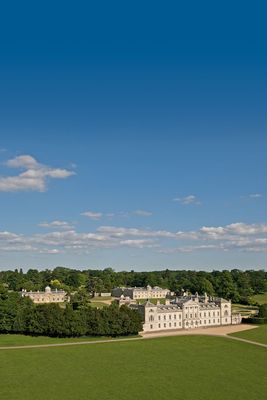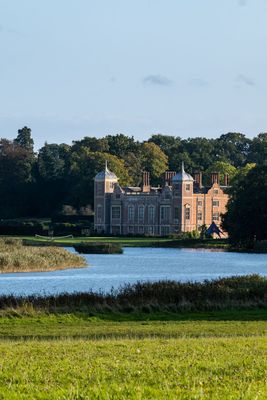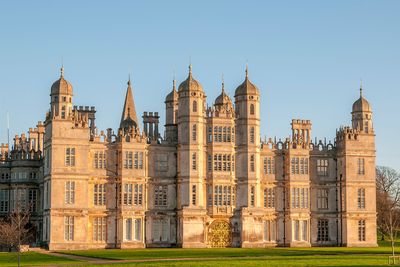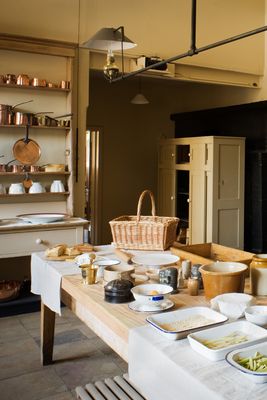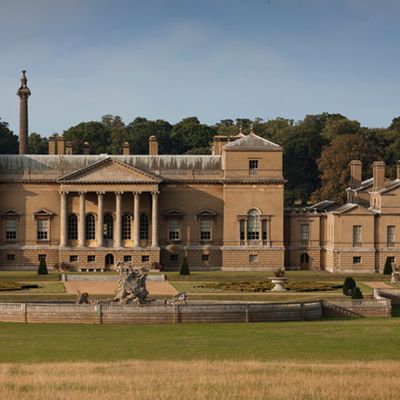
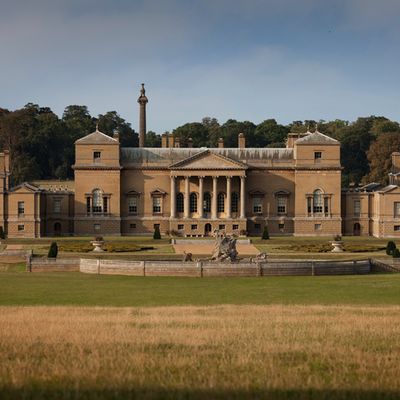
7 Stately Homes & Manor Houses To Visit In The East Of England
All products on this page have been selected by our editorial team, however we may make commission on some products.
HOUGHTON HALL
Where: Houghton, Norfolk.
Why: Built in the 1720s for Britain’s first prime minister, Sir Robert Walpole, Houghton Hall is one of Norfolk’s most beautiful stately homes and remains one of England’s finest Palladian houses. During his lifetime, Walpole amassed one of the greatest collections of European art in Britain but, after his death, his grandson was forced to sell much of it to Catherine the Great of Russia due to debts. Today, Houghton is home of the Marquess of Cholmondeley, a direct descendant of Walpole, his wife and family. For Blue Badge tourist guide Viv Haxby, “This wonderful house is the best experience of my guiding career to date. And the walled garden will make you heart sing!” This year, Houghton celebrates its 300th anniversary and has fully reopened the State Rooms for visitors. Several artworks have also been added to the collection for this celebratory year.
How: Click here for information.
HOLKHAM HALL
Where: Holkham, near Wells-next-the-Sea, Norfolk.
Why: Holkham Hall is an 18th-century stately home, constructed in the Palladian style for the 1st Earl of Leicester and, today, it is still home to the current Earl and his family. It is nestled within 25,000 acres of rolling parkland that is alive with deer and huge oak trees, and leads to an expansive beach backed by sand dunes and pine forests. “A visit will bring to life the stories of a bygone era and will give you a first-rate visitor experience,” Viv tells us. “It is simply magnificent and, although the house has a warm, lived-in feel, much of the original furniture remains in place from the 1700s.” As you enter, you’ll find the Marble Hall with its impressive 50ft dome ceiling and elegant walls of English alabaster (not marble as the name suggests). From here a grand staircase leads to the state rooms, from the Saloon with its rich, red walls, gilded coffering and lofty ceiling to several bedrooms where royalty once slept. You can also visit the dining rooms adorned with porcelain, galleries of statuary and art by the Old Masters, libraries and the old kitchen with its rows of polished copper pots, pans and moulds. Outside, the walled garden is undergoing a project to rejuvenate the six acres which were originally laid out in the late 1700s. You can see how the work is progressing and walk round the Georgian and Victorian greenhouses and vineries, the formal ornamental garden and kitchen garden.
How: Click here for information.
WOBURN ABBEY
Where: Woburn Park, Bedfordshire.
Why: Set in a beautiful 3,000-acre deer park, where more than ten species of deer roam free, Woburn Abbey has been the home of the Dukes of Bedford for 400 years. Today, it is lived in by the 15th Duke and Duchess of Bedford. The abbey and gardens are currently closed to the public for a massive restoration project, but Viv advises getting in line to visit when the doors reopen in the spring of 2024. You’ll be able to discover the 22 rooms open to visitors, including the grand state apartments with original 18th-century architecture, the Chinese Room with decorative wallpaper, the Holland Library, the shell-covered Grotto which dates from the 1630s, and the underground vaults. The abbey teems with treasures and houses one of the most important art collections in the world – Venetian paintings by Canaletto as well as works by Rembrandt, Gainsborough, Hogarth, Van Dyck, Reynolds and Tintoretto. Also owned by the Duke of Bedford is the nearby Woburn Safari Park, which is open now.
How: Click here for information.
BLICKLING HALL
Where: Blickling, near Norwich, Norfolk.
Why: This breath-taking mansion sits at the heart of a lovely garden and historic park in the Bure meadows. “For me, this one is all about the outside – it’s such a perfect Jacobean house,” Viv tells us. “The Boleyn family owned the original hall on this site from 1499 until 1505, and it was the birthplace of Anne Boleyn.” Surrounding the house, the ancient yew hedges and the formal garden are the result of three centuries of planting. Beyond, the parkland is great for exploring on foot or by bike, and for discovering the stunning views and wildlife. During the Second World War, Blickling Estate became billets for aircrew from nearby RAF Oulton, and the onsite museum remembers the men and women who served as part of Bomber Command.
How: Click here for information.
BURGHLEY HOUSE
Where: Stamford, Lincolnshire.
Why: Burghley is one of the largest and grandest surviving houses of the 16th century and “a magnificent example of the great Elizabethan ‘prodigy’ houses,” Viv says. Built between 1555 and 1587 by William Cecil, Lord High Treasurer to Queen Elizabeth I, his direct descendants have lived here ever since. It is currently home to Miranda Rock and her family. Visitors can enjoy a guided or self-guided tour of Burghley’s 18 lavishly decorated State Rooms and learn about the history of the house and the family. The impressive fine art is one of the highlights – the collection of Italian Old Master paintings is one of the best in private hands. In addition, there are world-famous collections of Oriental and European ceramics, including some renowned Chinese snuff bottles. Outside, the gardens and parkland were designed by Capability Brown in the 18th century. You can visit the Garden of Surprises, which was inspired by the Elizabethan fascination with astrology, astronomy and Classical civilisations; the Sculpture Garden where loaned and commissioned pieces are on display from April to October; and the rose garden. Beyond, the Deer Park has sweeping vistas through mature trees to the spires of Stamford.
How: Click here for information.
AUDLEY END HOUSE
Where: Near Saffron Walden, Essex.
Why: “One of our grandest mansions, Audley End is vast and extremely well presented by English Heritage,” says Viv. “It’s a great day out, too, as there is plenty to do.” Inside what was once one of the largest and most opulent houses in Jacobean England, you can discover what life was like above and below stairs in a Victorian country house – explore the impressive great hall, magnificent state apartments and dressing rooms as well as the servants’ wing, including the kitchens, dairy and laundry rooms. You can then wander the spacious grounds and admire the gardens designed by Capability Brown, including the beautifully restored parterre and organic kitchen gardens. There is also a memorial to Polish Resistance soldiers who trained here during the Second World War.
How: Click here for information.
SANDRINGHAM HOUSE
Where: Sandringham, Norfolk.
Why: Sandringham House is perhaps the most famous stately home in Norfolk. At the heart of the Sandringham Estate, it was Queen Elizabeth II’s much-loved country retreat and has been the private home of four generations of British monarchs. The house was built in 1870 by the Prince and Princess of Wales, who later became King Edward VII and Queen Alexandra. The main eight ground-floor rooms, regularly used by the royal family, are open to the public from April to October – and the decor and contents remain very much as they were in Edwardian times. “The highlight for me was seeing where our late Queen did her jigsaws,” says Viv. Visitors can also enjoy the lovely garden areas that are dotted with trees of all ages, including an oak tree planted by Queen Victoria and a giant redwood planted by Princess Christian of Denmark. The oldest tree in the garden is a veteran oak beside the upper lake, which is said to be over 800 years old. Beyond the gardens, the dog-friendly Sandringham Royal Park, which is open to the public year-round, has an abundance of animals, birds and plants. It can be explored on foot or by bike – there are two marked nature trails to follow, or you can follow the many other woodland paths. The house, gardens and St Mary Magdalene Church are open until 13th October and will reopen in the spring.
How: Click here for information.
Viv Haxby is a Blue Badge tourist guide, a driver guide and a member of the Institute of Tourist Guiding.
If you have missed previous articles on the best stately homes and mansions to visit in Britain, click on the following links: The Heart of England, The North, Scotland, The South East and The South West.
DISCLAIMER: We endeavour to always credit the correct original source of every image we use. If you think a credit may be incorrect, please contact us at info@sheerluxe.com.

